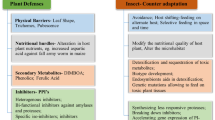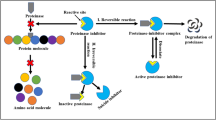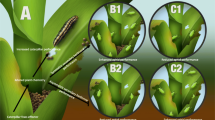Abstract
Plant protease inhibitors (PIs) are among the most well-studied and widely distributed resistance traits that plants use against their herbivore attackers. There are different types of plant PIs which putatively function against the different types of proteases expressed in insect guts. Serine protease inhibitors (SPIs) and cysteine protease inhibitors (CPIs) are hypothesized to differentially function against the predominant gut proteases in lepidopteran and coleopteran herbivores, respectively. Here, we test the hypothesis that tall goldenrod, Solidago altissima, can specifically respond to damage by different herbivores and differentially induce SPIs and CPIs in response to damage by lepidopteran and coleopteran herbivores. Moreover, we ask if the concerted induction of different types of PIs accounts for variation in induced resistance to herbivory. We altered and optimized a rapid and effective existing methodology to quantitatively analyze both SPI and CPI activity simultaneously from a single tissue sample and to use the same plant extracts directly for characterization of inhibitory effects on insect gut protease activity. We found that both SPIs and CPIs are induced in S. altissima in response to damage, regardless of the damaging herbivore species. However, only SPIs were effective against Spodoptera exigua gut proteases. Our data suggest that plant PI responses are not necessarily specific to the identity of the attacking organism but that different components of generally induced defense traits can specifically affect different herbivore species. While providing an efficient and broadly applicable methodology to analyze multiple PIs extracted from the same tissue, this study furthers our understanding of specificity in induced plant resistance.





Similar content being viewed by others
References
Agrawal AA, Sherriffs MF (2001) Induced plant resistance and susceptibility to late-season herbivores of wild radish. Ann Entomol Soc Am 94:71–75
Benchabane M, Schluter U, Vorster J, Goulet MC, Michaud D (2010) Plant cystatins. Biochimie 92:1657–1666
Bhavani P, Bhattacherjee C, Prasad DT (2007) Bioevaluation of subabul (Leucaena leucocephala) proteinase inhibitors on Helicoverpa armigera. Arthropod Plant Interact 1:255–261
Bode RF, Kessler A (2012) Herbivore pressure on goldenrod (Solidago altissima L., Asteraceae): its effects on herbivore resistance and vegetative reproduction. J Ecol 100:795–801
Bolter CJ (1993) Methyl jasmonate induces papain inhibitor(s) in tomato leaves. Plant Physiol 103:1347–1353
Bolter CJ, Jongsma MA (1995) Colorado potato beetles (Leptinotarsa decemlineata) adapt to proteinase-inhibitors induced in potato leaves by methyl jasmonate. J Insect Physiol 41:1071–1078
Bolter CJ, LatoszekGreen M (1997) Effect of chronic ingestion of the cysteine proteinase inhibitor, E-64, on Colorado potato beetle gut proteinases. Entomol Exp Appl 83:295–303
Bouchard E, Cloutier C, Michaud D (2003) Oryzacystatin I expressed in transgenic potato induces digestive compensation in an insect natural predator via its herbivorous prey feeding on the plant. Mol Ecol 12:2439–2446
Bradford MM (1976) Rapid and sensitive method for quantitation of microgram quantities of protein utilizing principle of protein-dye binding. Anal Biochem 72:248–254
Broadway RM (1997) Dietary regulation of serine proteinases that are resistant to serine proteinase inhibitors. J Insect Physiol 43:855–874
Chung SH, Felton GW (2011) Specificity of induced resistance in tomato against specialist Lepidopteran and Coleopteran species. J Chem Ecol 37:378–386
Clark TM (1999) Evolution and adaptive significance of larval midgut alkalinization in the insect superorder Mecopterida. J Chem Ecol 25:1945–1960
Espinosa EG, Fornoni J (2006) Host tolerance does not impose selection on natural enemies. New Phytol 170:609–614
Farmer EE, Ryan CA (1990) Interplant communication—airborne methyl jasmonate induces synthesis of proteinase inhibitors in plant leaves. Proc Natl Acad Sci USA 87:7713–7716
Garcia-Olmedo F, Salcedo G, Sanchez-Monge R, Gomez L, Royo J, Carbonero P (1987) Plant proteinaceous inhibitors of proteinases and alpha amylases. In: Miflin BJ (ed) Oxford surveys of plant molecular and cell biology, vol 4, Oxford University Press, Oxford, pp 275–334 (p 365)
Glawe GA, Zavala JA, Kessler A, Van Dam NM, Baldwin IT (2003) Ecological costs and benefits correlated with trypsin protease inhibitor production in Nicotiana attenuata. Ecology 84:79–90
Goulet MC, Dallaire C, Vaillancourt LP, Khalf M, Badri AM, Preradov A, Duceppe MO, Goulet C, Cloutier C, Michaud D (2008) Tailoring the specificity of a plant cystatin toward herbivorous insect digestive cysteine proteases by single mutations at positively selected amino acid sites. Plant Physiol 146:1010–1019
Green TR, Ryan CA (1972) Wound-induced proteinase inhibitor in plant leaves: a possible defence mechanism against insects. American association for the advancement of science. Science 175:776–777
Gruden K, Strukelj B, Popovic T, Lenarcic B, Bevec T, Brzin J, Kregar I, Herzog-Velikonja J, Stiekema WJ, Bosch D, Jongsma MA (1998) The cysteine protease activity of Colorado potato beetle (Leptinotarsa decemlineata Say) guts, which is insensitive to potato protease inhibitors, is inhibited by thyroglobulin type-1 domain inhibitors. Insect Biochem Mol Biol 28:549–560
Gustafson G, Ryan CA (1976) Specificity of protein turnover in tomato leaves—accumulation of proteinase inhibitors, induced with wound hormone, PIIF. J Biol Chem 251:7004–7010
Hernandez CA, Pujol M, Alfonso-Rubi J, Armas R, Coll Y, Perez M, Gonzalez A, Ruiz M, Castanera P, Ortego F (2003) Proteolytic gut activities in the rice water weevil, Lissorhoptrus brevirostris Suffrian (Coleoptera: Curculionidae). Arch Insect Biochem Physiol 53:19–29
Hilder VA, Gatehouse AMR, Sheerman SE, Barker RF, Boulter D (1987) A novel mechanism of insect resistance engineered into tobacco. Nature 330:160–163
Johnson KS, Rabosky D (2000) Phylogenetic distribution of cysteine proteinases in beetles: evidence for an evolutionary shift to an alkaline digestive strategy in Cerambycidae. Comp Biochem Physiol B Biochem Mol Biol 126:609–619
Jongsma MA, Bolter C (1997) The adaptation of insects to plant protease inhibitors. J Insect Physiol 43:885–895
Jongsma MA, Beekwilder J, Schaller A (2008) Plant protease inhibitors: functional evolution for defense induced plant resistance to herbivory. Springer, Netherlands, pp 235–251
Karban R, Baldwin IT (1997) Induced responses to herbivory. The University of Chicago Press, Chicago
Kessler A, Baldwin IT (2002a) Manduca quinquemaculata’s optimization of intra-plant oviposition to predation, food quality, and thermal constraint’s. Ecology 83:2346–2354
Kessler A, Baldwin IT (2002b) Plant responses to insect herbivory: the emerging molecular hypothesis. Annu Rev Plant Biol 53:299–328
Kessler A, Halitschke R (2007) Specificity and complexity: the impact of herbivore-induced plant responses on arthropod community structure. Curr Opin Plant Biol 10:409–414
Koiwa H, Bressan RA, Hasegawa PM (1997) Regulation of protease inhibitors and plant defense. Trends Plant Sci 2:379–384
Lawrence SD, Novak NG, Blackburn MB (2007) Inhibition of proteinase inhibitor transcripts by Leptinotarsa decemlineata regurgitant in Solanum lycopersicum. J Chem Ecol 33:1041–1048
Maddox GD, Root RB (1987) Resistance to 16 diverse species of herbivorous insects within a population of goldenrod, Solidago altissima—genetic variation and heritability. Oecologia 72:8–14
Maddox GD, Root RB (1990) Structure of the encounter between goldenrod (Solidago altissima) and its diverse insect fauna. Ecology 71:2115–2124
Oppert B, Morgan TD, Hartzer K, Kramer KJ (2005) Compensatory proteolytic responses to dietary proteinase inhibitors in the red flour beetle, Tribolium castaneum (Coleoptera: Tenebrionidae). Comp Biochem Physiol C Toxicol Pharmacol 140:53–58
Oppert B, Elpidina EN, Toutges M, Mazumdar-Leighton S (2010) Microarray analysis reveals strategies of Tribolium castaneum larvae to compensate for cysteine and serine protease inhibitors. Comp Biochem Physiol D Genomics Proteomics 5:280–287
Poelman EH, Galiart RJFH, Raaijmakers CE, van Loon JJA, van Dam NM (2008) Performance of specialist and generalist herbivores feeding on cabbage cultivars is not explained by glucosinolate profiles. Entomologica Experimentalis et Applicata 127:218–228
Romeo JT, Saunders JA, Barbosa P (1996) Phytochemical diversity and redundancy in ecological interactions. Plenum Press, New York and London
Root RB (1996) Herbivore pressure on goldenrods (Solidago altissima): its variation and cumulative effects. Ecology 77:1074–1087
Root RB, Cappuccino N (1992) Patterns in population change and the organization of the insect community associated with goldenrod. Ecol Monogr 62:393–420
Steppuhn A, Baldwin IT (2007) Resistance management in a native plant: nicotine prevents herbivores from compensating for plant protease inhibitors. Ecol Lett 10:499–511
Stout MJ, Workman KV, Bostock RM, Duffey SS (1998) Specificity of induced resistance in the tomato, Lycopersicon esculentum. Oecologia 113:74–81
Strukelj B, Pungercar J, Mesko P, Barlicmaganja D, Gubensek F, Kregar I, Turk V (1992) Characterization of aspartic proteinase inhibitors from potato at the gene, cDNA and protein levels. Biol Chem (Hoppe-Seyler) 373:477–482
Tooker JF, Rohr JR, Abrahamson WG, De Moraes CM (2008) Gall insects can avoid and alter indirect plant defenses. New Phytol 178:657–671
Underwood N, Morris W, Gross K, Lockwood Iii JR (2000) Induced resistance to Mexican bean beetles in soybean: variation among genotypes and lack of correlation with constitutive resistance. Oecologia 122:83–89
Van Dam NM, Horn M, Mares M, Baldwin IT (2001) Ontogeny constrains systemic protease inhibitor response in Nicotiana attenuata. J Chem Ecol 27:547–568
Viswanathan DV, Thaler JS (2004) Plant vascular architecture and within-plant spatial patterns in resource quality following herbivory. J Chem Ecol 30:531–543
Viswanathan DV, Narwani AJT, Thaler JS (2005) Specificity in induced plant responses shapes patterns of herbivore occurrence on Solanum dulcamara. Ecology 86:886–896
Viswanathan DV, Lifchits OA, Thaler JS (2007) Consequences of sequential attack for resistance to herbivores when plants have specific induced responses. Oikos 116:1389–1399
Voelckel C, Baldwin IT (2004) Generalist and specialist lepidopteran larvae elicit different transcriptional responses in Nicotiana attenuata, which correlate with larval FAC profiles. Ecol Lett 7:770–775
Wise MJ (2009) Competition among herbivores of Solanum carolinense as a constraint on the evolution of host-plant resistance. Evol Ecol 23:347–361
Wolfson JL, Murdock LL (1987) Suppression of larval Colorado potato beetle growth and development by digestive proteinase inhibitors. Entomol Exp Appl 44:235–240
Zavala JA, Patankar AG, Gase K, Baldwin IT (2004a) Constitutive and inducible trypsin proteinase inhibitor production incurs large fitness costs in Nicotiana attenuata. Proc Natl Acad Sci USA 101:1607–1612
Zavala JA, Patankar AG, Gase K, Hui DQ, Baldwin IT (2004b) Manipulation of endogenous trypsin proteinase inhibitor production in Nicotiana attenuata demonstrates their function as antiherbivore defenses. Plant Physiol 134:1181–1190
Zhao Y, Botella MA, Subramanian L, Niu XM, Nielsen SS, Bressan RA, Hasegawa PM (1996) Two wound-inducible soybean cysteine proteinase inhibitors have greater insect digestive proteinase inhibitory activities than a constitutive homolog. Plant Physiol 111:1299–1306
Acknowledgments
We would like to thank Ellen Fagan, Kimberly Morrell, Akane Uesugi, and Justin Porter for assistance with collecting plants and animals. We also thank Robert H. Johnson for introducing us to the intricacies of the Solidago system and advice on how to grow Solidago clones. We thank the editor and three anonymous reviewers for their very constructive comments that significantly improved this paper. We thank the USA National Science Foundation that provided funding for this study through grant awards NSF-IOS 0950225 and NSF-DEB 1010726.
Author information
Authors and Affiliations
Corresponding author
Electronic supplementary material
Below is the link to the electronic supplementary material.
Rights and permissions
About this article
Cite this article
Bode, R.F., Halitschke, R. & Kessler, A. Herbivore damage-induced production and specific anti-digestive function of serine and cysteine protease inhibitors in tall goldenrod, Solidago altissima L. (Asteraceae). Planta 237, 1287–1296 (2013). https://doi.org/10.1007/s00425-013-1845-9
Received:
Accepted:
Published:
Issue Date:
DOI: https://doi.org/10.1007/s00425-013-1845-9




